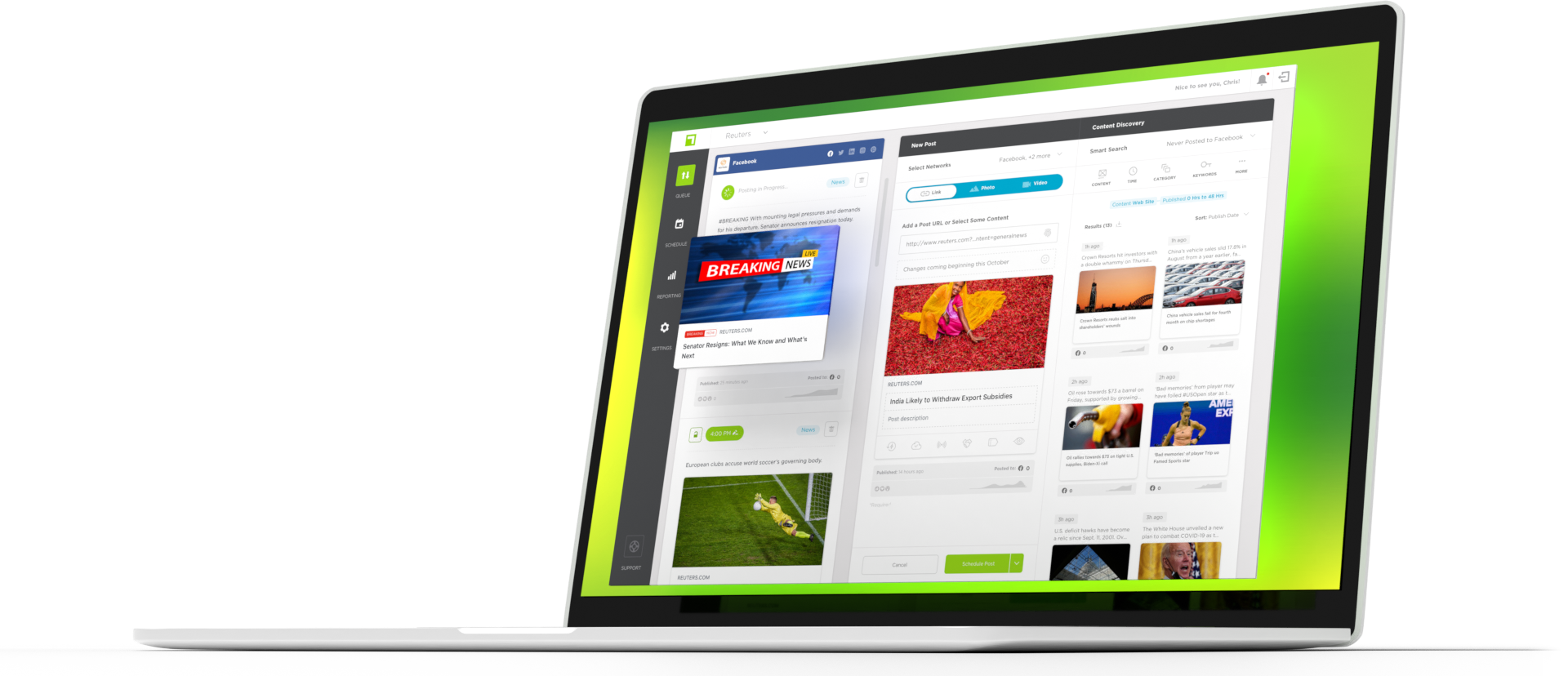Despite what you may have heard, Facebook still dominates the social media landscape. Facebook has fiercely grown to 3 billion users after 20 years. This surprising growth is partly thanks to Facebook algorithm change, a sophisticated tool leveraging the power of AI to provide users with an entirely personalized experience.
What does this mean for publishers? If you have Facebook in your current social media strategy, keep it there. If it’s not yielding the results you hoped, it’s certainly not a lost cause. The Facebook algorithm is not a code to be cracked or a puzzle to solve. It’s constantly evolving and changing with trends. Staying relevant requires social media teams to constantly adjust, test, and strengthen their strategies to keep audiences interested.
In this article, we’ll discuss the Facebook algorithm, how AI influences these algorithms, and tips to help you optimize your content for success.
Why do publishers need to know about algorithms?
First, let’s talk about why it’s essential to know the details about an algorithm. Why should publishers care?
Social media algorithms are intricate and complicated. They can be hard to decipher and even harder to please. Unfortunately, they are also pretty powerful regarding who, when, and how much of your content is pushed onto a user’s feed.
While we don’t condone cracking or bowing to these algorithms, you can’t entirely ignore them. The more you understand these tools, the less you will feel at their mercy for your online success and the better strategy you can create for reaching audiences online.
Facebook algorithm for 2024
AI heavily powers Facebook’s algorithm; it’s really just a set of rules and machine learning tools. These rules dictate who sees your content based on engagement, style, consistency, and authenticity indicators. It’s a machine that delivers based on what it’s programmed to do.
The number one objective of the Facebook algorithm change is to make the user experience unique. The goal is to ensure that no two feeds are alike, providing complete personalization and tailored content.
Types of content to know
There are three types of content publishers should be familiar with that Facebook pushes onto news feeds:
- Recommended Content: Posts from pages or accounts the user may not follow but may be interested in.
- Connected Content: Posts from accounts and groups a user follows.
- Advertisements: Ads governed by a third party are shown to users as they scroll.
In 2024, Facebook will be evaluating this content on a four-rank process, looking at the following metrics:
- Signals: This is how Facebook gauges relevance. This includes the timing, interaction, content type, engagement, internet speed, etc.
- Inventory: Facebook looks at the inventory of posts, pages, and groups of users.
- Relevance: Facebook will assign a score to content for its relevance before pushing it onto a user’s feed.
- Predictions: The platform looks at user behavior to predict what content they might be interested in.
Facebook Reels will prioritize content that includes trending elements, quality, originality, compliance with the Facebook community guidelines, personalization, and, most importantly, engagement.
Types of content to avoid
Facebook has strict guidelines for what users can and cannot post. In 2024, the algorithm can pick up community guidelines violations quickly. Make sure to avoid types of content including:
- Low-quality content
- Questionable posts
- Sensitive content
- Content that compromises safety
- Clickbait
- False news
AI influences in Facebook algorithm
AI technology is the powerhouse behind helping Facebook accomplish its objective of a personalized platform. These algorithms are perfect for reaching current audiences, discovering new audiences, recognizing user patterns, and suggesting similar content. This is a crucial benefit for any brand looking to connect with a specific group of people among billions of active users.
Integrating AI and social media algorithms also increases a brand’s potential for organic reach on the platform. Organic growth is cost-effective and often yields long-term results for securing a loyal audience. Before the Facebook algorithm change, brands had to make a considerable effort to find their audience and stay at the top of the feed. Now, if publishers can optimize and personalize their content, the Facebook algorithm will (in a sense) help your content find your audience.
Guidelines for working with Facebook algorithm
When you’re looking to work with the Facebook algorithm, remember you are not creating content to please it. If you have things working in your current social media strategy, keep doing this. Use these guidelines to enhance and strengthen your current efforts.
Stay relevant and loyal to your audience
Your social media goal should never be just to go viral or jump your follower count up quickly. Your goal should be to connect with new audiences and maintain your current audience of loyal users. Stay true to your audience and your brand’s mission when creating your content. Don’t sacrifice quality for quantity.
Encourage engagement
Engagement, engagement, engagement. We cannot stress enough how much social media platforms love engagement. Your content should be exciting and enticing enough for your audience to share and engage with before scrolling on. Brands should also respond to their audience when engaging to establish real connections in the online space.
Now, this is easier said than done, considering Facebook accounts of all sizes have been experiencing drops in engagement over the last few years. However, we have some tips for building more Facebook traffic to spark engagement on your account.
Avoid clickbait engagement
When we say build engagement, it has to be authentic. Users will not engage with content with a clear clickbait headline or vibe. If they do engage because they trust your account and are disappointed, you probably just lost some of your loyal audience.
Experiment with different types of content
Don’t stick to one type of content your audience likes. Only posting videos or images will pigeonhole your reach into only accessing users who enjoy that type. Make sure you post a variety of images, carousels, videos, infographics, and stories. Keep your audience interested!
Utilize UGC content and tag users
User Generated Content (UGC) is incredibly powerful for brands. This type of content helps businesses build relationships, establish credibility, and broaden their access to different audiences. Ensure you post UGC within your strategy and mention the creators in your posts. This is a big one for 2024 marketing and should be prioritized.
Continue video content
If you’re posting video content already, keep going! Video is still just as popular and isn’t going anywhere. Remember to format your videos specifically for Facebook. We have more tips for creating and using short-form videos on Facebook to help your brand succeed online.
Keep posting your status
Oh yes, the Facebook status is still a thing! In 2024, brands should continue to update their Facebook status to keep their users informed. This is a great place to keep users updated on new events, stay up to date with any current events in the world, or share company news.
No fake news
This is extremely important for publishers and broadcasters; do not post fake news. It’s against Facebook community guidelines to spread inaccurate and hateful posts. Spreading fake news is the quickest way to get removed from the platform. Only post well-researched and accurate content.
True Anthem can help with Facebook
You don’t have to fear the Facebook algorithm, but we understand if you’re overwhelmed. It takes more than just understanding how an algorithm works to be successful on social media. We can help with that.
True Anthem helps publishers and broadcasters succeed alongside social media algorithms by using our AI tools to keep up. Our tool ensures brands stay consistent with their style, scheduling, and publishing by learning your audience and content. We help you create a solid social media strategy to get your content in front of the right people at the right time.
Reach out to chat more about automating your social media strategy, or click here to set up a demo.

